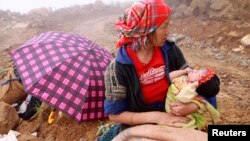Michael Yates remembers recently seeing footage of a South Asian woman who woke up in the middle of the night surrounded by water. She grabbed her children and fled to higher ground, but left everything behind in the flooding, as he recalls.
Yates, the director for the U.S. Agency for International Development’s mission in Asia, said that inexpensive tools like early warning systems might have helped this woman minimize her losses. These are the types of remedies USAID was looking for as it announced a $100 million fund on Wednesday to tackle natural disasters, climate change and other crises.
But the so-called Global Resilience Partnership in Asia and Africa, co-launched with the Rockefeller Foundation, is not a humanitarian relief fund. For starters, it’s putting out a call for creative proposals to help those in developing countries better prepare for disaster or recover from it more quickly.
“People should be energized into bringing out their best and brightest ideas,” Yates told reporters via video conference from Bangkok.
A typical relief fund would provide food, medical care and shelter after catastrophes like Typhoon Haiyan, which struck Southeast Asia in November. By contrast, the resilience partnership aims to use technology and other ideas to minimize the damage from the beginning. Gauges to monitor rivers, for instance, could be paired with SMS and email warnings, so that people can anticipate rising water levels.
Sponsors view the approach as an investment with dividends. When victims lose less of their property or livelihoods at the start of a crisis, they can avoid tough decisions down the line that often multiply the damage, such as skipping school to use tuition money for food.
Could save billions
Ashvin Dayal, managing director of the Rockefeller Foundation, said the partnership could net savings for countries and individuals. While $100 million is a modest amount, its impact could be much larger because it could prevent losses during natural disasters and because governments would not have to repeatedly spend funds on the same problems year after year.
“When you aggregate it, this dividend runs into billions of dollars per year and something that could be of macroeconomic importance to a country,” said Dayal, who also was on the conference call.
The resilience partnership, which targets South and Southeast Asia, the Horn of Africa, and the Sahel, will start taking submissions for inventive solutions in September. The contest is expected to award funds to the winning applications in early 2015 and will focus on groups from different sectors that come together to form multi-disciplinary teams.
“Our intention is to work with USAID missions and other partners throughout the region to ensure that they’re incorporating resilience into all of their programming,” Yates said. “Not just our environment portfolio, but our health portfolio, our agricultural portfolio. Resilience is something that needs to be integrated in everything we do.”
Aiming for a mix of solutions
Dayal said that they’re seeking ideas in three categories: predictive analytics and technologies; measurement and metrics; and innovative and flexible financing.
Financing would encourage investors to channel capital into areas that help families plan for the future. A low-income housing upgrade fund, for example, would lend money to those who don’t have the few hundred dollars needed to renovate their homes for storm protection, even though it could save thousands of dollars later.
Other solutions the sponsors floated include crowd-sourced data collection and crisis mapping. In dealing with food insecurity and climate change, they discussed ongoing experiments with drought-resistant corn as well as strains of rice that could tolerate flood or increasing amounts of salt from encroaching seawater.
The fund partners estimate that weather-related disasters cost the world $200 billion annually, an increase of 300 percent in the past 30 years. While $100 million is just a drop in the bucket by comparison, Dayal said that figure is likely to grow as they appeal to public and private donors.
“This is a $100-million initial investment by two organizations,” Dayal said. “It is very much our ambition and our hope that in the next year or so we will bring new partners into this and we can grow the fund. So hopefully success will breed more interest.”





